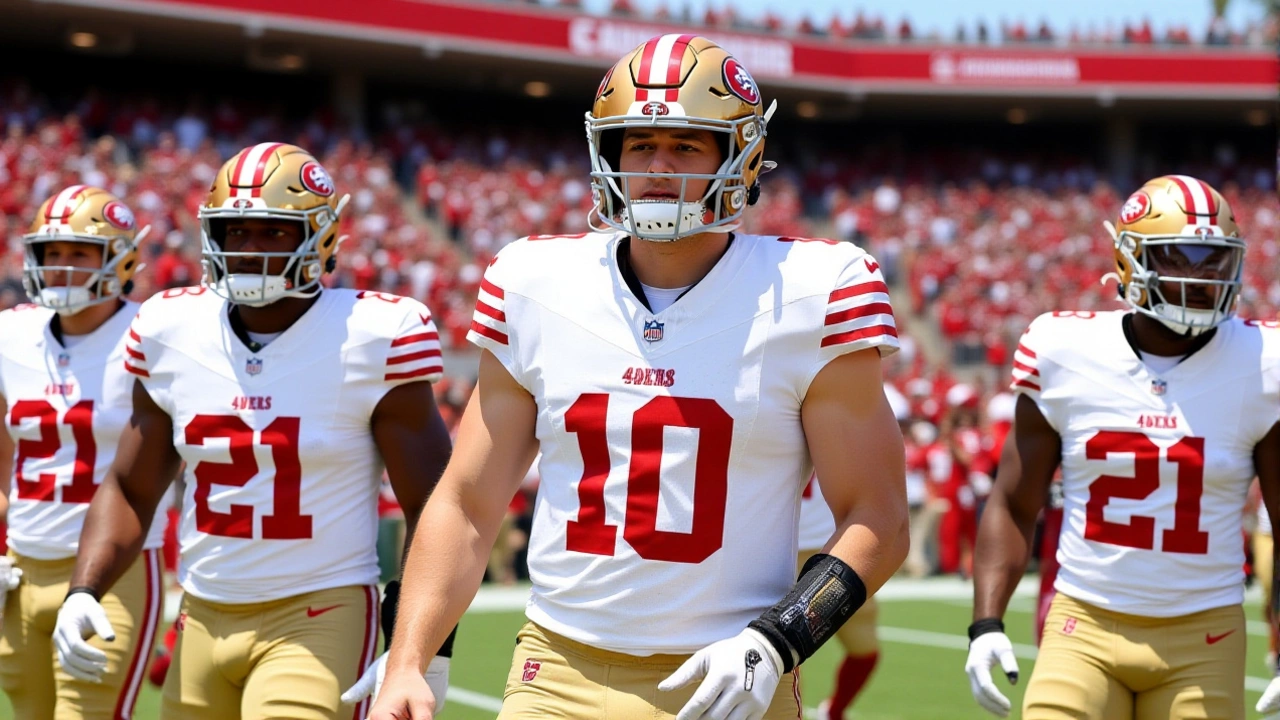When the San Francisco 49ers released their official 2025 depth chart, the most telling detail wasn’t the team’s 7-4 record or Fred Warner’s injury status—it was the quiet placement of Mac Jones as the clear second-string quarterback behind Brock Purdy. It’s not just a roster move. It’s a statement. And maybe, just maybe, it’s the start of a quiet reclamation project.
Why This Isn’t Just a Backup Role
Brock Purdy, 25, isn’t just the starter—he’s the franchise. His contract, confirmed by 49erscap.com, runs through 2030. That’s six years. That’s not a bet on potential. That’s a long-term marriage. And yet, the 49ers didn’t go out and sign a veteran stopgap. They didn’t trade for a proven name. They kept Mac Jones, the former New England Patriots starter who’s been through the wringer: a fall from grace in Foxborough, a brief, unremarkable stint with the Jacksonville Jaguars, and now, a second chance in Santa Clara. Jones, 27, wears jersey #10. His contract expires after 2026. That’s not an accident. The 49ers aren’t paying him like a future starter. They’re paying him like a project. Someone to learn, to absorb, to grow under the watchful eye of San Francisco 49ers head coach Kyle Shanahan—even if no one’s saying it outright.The Roster Architecture Behind the Scenes
The 49ers carry three quarterbacks. Purdy. Jones. And Kurtis Rourke, a 24-year-old Ohio University alum listed as “NFI” on OurLads.com’s depth chart. NFI means Non-Facility—essentially, he’s on the roster but not practicing. He’s a developmental afterthought. That tells you everything: Jones isn’t the third-string guy. He’s the backup. The only one who gets reps with the twos. The only one who’s expected to know the playbook inside out. And here’s the twist: Jones isn’t just a warm body. He’s got experience. Eight NFL seasons. Started 31 games. Led a playoff run in 2021. But his mechanics broke down under pressure. His decision-making got sluggish. The Patriots moved on. The Jaguars didn’t trust him. Now, he’s in a system that values precision, timing, and rhythm—the exact things Shanahan’s offense demands. If anyone can fix Jones’ footwork and rhythm, it’s this staff.What This Means for the 49ers’ Future
Purdy’s contract locks him in until 2030. That’s a luxury most teams don’t have. Most franchises are scrambling to find their next QB. The 49ers already have theirs. So why keep Jones? Because they’re thinking ahead—not just for next year, but for 2027 and beyond. What if Purdy gets hurt? What if he declines after 2027? What if Shanahan wants to move on from him in 2028? Jones is the perfect insurance policy: a known quantity with NFL experience, a contract that ends in 2026, and a salary cap hit that won’t cripple the team. He’s not expensive. He’s not a distraction. He’s just… there. Ready. The salary cap numbers back this up. Purdy’s deal is long-term, but not bloated. Jones’ deal is modest. The 49ers have $18.7 million in projected cap space for 2025, according to OverTheCap.com. They could afford to add a rookie in 2026 if they wanted. But they didn’t. They kept Jones. That’s telling.The Quiet Opportunity
No one’s calling Jones the next starter. No one’s saying he’ll replace Purdy. But here’s what’s happening: every time Purdy sits out a practice, Jones takes the first-team reps. Every time Shanahan runs a two-minute drill, Jones is the one running it. Every time the offense needs to simulate a late-game scenario, Jones is the guy in the huddle. This isn’t just backup duty. This is apprenticeship. And if Jones can rediscover the poise he showed in 2021—the calm, accurate, efficient quarterback who led the Patriots to a 10-7 record in his first 17 starts—he could become the ultimate bridge. A guy who can step in for a season if needed, then be traded for a mid-round pick in 2027. Or, if he surprises everyone, he could become the guy who holds the fort until the next draft gem arrives.What’s Next?
The 49ers face a critical stretch: five of their final six games are against teams currently above .500. If Purdy stays healthy, they’ll likely win the NFC West. If he doesn’t? Watch Jones. Watch how he handles pressure. Watch how he reads coverage. Watch how he moves in the pocket. The 49ers aren’t talking about this. They never do. But if Jones starts showing flashes—tighter throws, quicker decisions, fewer turnovers—it won’t be an accident. It’ll be the result of a quiet, deliberate plan. And if it works? Look for Jones to be the most valuable non-starter in the NFL next year.Frequently Asked Questions
Why is Mac Jones still with the 49ers after his struggles in New England and Jacksonville?
The 49ers see Jones as a low-risk, high-reward project. At 27, he’s still young enough to adapt, and his familiarity with Shanahan’s system—built on timing and rhythm—gives him an edge over younger, less experienced backups. His 2026 contract expiration means the team can release him without dead money, making him ideal insurance rather than a long-term commitment.
Could Mac Jones become the starter if Brock Purdy gets injured?
Yes, and that’s exactly why he’s on the roster. Jones has started 31 NFL games and knows how to manage a high-powered offense. If Purdy goes down, Jones isn’t just a placeholder—he’s the most prepared backup in the league to handle Shanahan’s complex system. The 49ers wouldn’t have kept him otherwise.
How does this affect the 49ers’ draft strategy in 2026?
With Jones under contract until 2026, the 49ers can afford to wait on a quarterback in the draft. They don’t need to use a first-rounder next April. Instead, they can focus on defense or offensive line, knowing Jones can cover the position for at least one more season. That flexibility is rare in today’s NFL.
What’s the significance of Kurtis Rourke being on the Non-Facility list?
Rourke’s NFI status means he’s not practicing with the team, likely due to injury or development status. He’s a developmental project with no immediate role, which underscores that Jones isn’t just the backup—he’s the only QB on the roster with real NFL experience behind Purdy. Rourke is a long-term gamble, not a short-term solution.
Is this a sign that Kyle Shanahan is grooming Jones to be his next offensive coordinator?
No—there’s no evidence Shanahan is planning to transition Jones into coaching. But Jones’ deep understanding of the offense, combined with his experience, makes him a natural candidate for a future role as a QB coach or assistant. That’s a bonus, not the goal. The goal is to keep the QB room stable and prepared.
How does this impact the 49ers’ chances in the playoffs?
With Purdy healthy, the 49ers are Super Bowl contenders. But if he’s out, Jones gives them a legitimate shot. He’s not a star, but he’s not a liability. He’s the kind of backup who can win a game or two with smart play and minimal mistakes—exactly what the 49ers need in a short playoff run. That’s more valuable than a flashy, unproven rookie.

